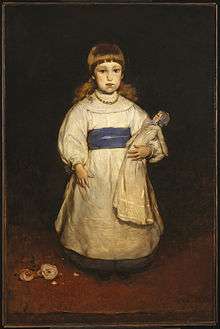Mary Cabot Wheelwright

Mary Cabot Wheelwright (October 22, 1878 – July 29, 1958) was an American anthropologist and museum founder. She established the museum which is now called Wheelwright Museum of the American Indian, in 1937[1] along with Hosteen Klah.[2]
Early life and family
Wheelwright was born on October 22, 1878, the only child of Andrew Cunningham Wheelwright and Sarah ("Sadie")[3] Perkins Cabot Wheelwright.[4] She was raised in a wealthy household and the Cabot family was part of the Boston upper class.[4] Her family traced its ancestry to 18th-century merchants who had become wealthy through shipping.[3] Her great-grandfathers worked as commission agents and her maternal grandfather made his wealth through "slavery, sugar, and rum," also building China's first trading outpost, where he imported silks and opium.[5] Mary's mother, Sarah, was close friends with Ralph Waldo Emerson,[3] who often visited the family's home.[2] As a child, Wheelwright was raised in the tradition of the Transcendentalists and the Unitarian Church.[3] In 1882, at the age of four years old, she posed for a portrait by artist Frank Duveneck.[6] She was well-traveled, visiting Europe, Egypt, and California with her parents, who were "protective" and raised Wheelwright as how a friend described as "growing up in cotton wool."[3]
For 40 years, Wheelwright remained the "dutiful Victorian daughter."[7] She devoted herself to "good works, particularly a settlement-house music school in the South End of Boston."[7] As the heiress of a family trust, she had significant income that would support her throughout her life but lacked control of the capital, which was intended to protect her from "fortune-hunting suitors" but made her unable to endow the museum she would later found as she wished.[7]
Life and work in the American Southwest
At age 40, after both her parents had died, Wheelwright journeyed to the American Southwest, where she "found and embraced a more primitive type of civilization, more adventuresome and more exciting than the safety of Boston."[4] In Alcalde, New Mexico, she stayed on a ranch.[4] In addition, she traveled to the Four Corners region and Navajo reservation.[4] There, she developed an interest in Navajo religion.[4] In 1921, Wheelwright was introduced to Hosteen Klah, a Navajo medicine man and singer, who was worried about preserving traditional Navajo religious practices.[4] The two developed a friendship and began working together to preserve Navajo religious practices, with Klah sharing details about Navajo ceremonies with Wheelwright, who recorded and translated them.[4] While at the time, there was a taboo in the Navajo community against replicating ceremonies, Klah's fear of the knowledge of his culture's traditions being lost led him to share the information with Wheelwright.[2]
Throughout the next years, Wheelwright spent time traveling the world, living in the eastern United States, and living in Alcalde.[4] In 1940, she traveled to India with the goal of finding symbols related to the ones found in Navajo art.[2] She also visited Europe, Greece, Egypt, and China.[2] She continued to record information about Navajo ceremonials given by Klah and by another 58 medicine men, and collected reproductions of ceremonial sandpaintings in various media.[4]
In 1923, Wheelwright purchased the Los Luceros Ranch near Alcalde.[7] She befriended Maria Chabot, who managed the ranch for 20 years, and later gifted the ranch to Chabot.[8]
In 1937, Wheelwright and Klah established the House of Navajo Religion in Santa Fe.[4] The name was later changed to the Museum of Navajo Ceremonial Art in 1939.[2] In 1977, it was renamed the Wheelwright Museum of the American Indian.[4]
Wheelwright wrote an autobiography, titled Journey Towards Understanding, in 1957.[2] Ultimately, it went unpublished during her lifetime.[2] An excerpt was published in A Quilt of Words: Women's Diaries, Letters & Original Accounts of Life in the Southwest, 1860–1960 in 1988.[2]
In addition to traveling, Wheelwright enjoyed sailing.[2] She spent summers on the coast of Maine and lived alone for a time in a shipmaster's cottage on Sutton Island.[2]
Later life and death
Wheelwright continued to serve as director of the museum for the rest of her life.[4] She died on July 29, 1958[4] at the age of 79 in her home in Maine.[5]
References
- ↑ "Wheelwright Museum of the American Indian—American Southwest—A National Register of Historic Places Travel Itinerary". www.nps.gov. Retrieved 2016-05-13.
- 1 2 3 4 5 6 7 8 9 10 11 Niederman, Sharon (1988). A Quilt of Words: Women's Diaries, Letters & Original Accounts of Life in the Southwest, 1860–1960. Big Earth Publishing. pp. 137–152. ISBN 9781555660475.
- 1 2 3 4 5 Inc., Mindshare Studios,. "» A Certain Fire: Mary Cabot Wheelwright Collects the Southwest". wheelwright.org. Retrieved 2016-05-12.
- 1 2 3 4 5 6 7 8 9 10 11 12 13 14 "Wheelwright, Mary C.". socialarchive.iath.virginia.edu. Retrieved 2016-05-12.
- 1 2 Writer, Kathaleen Roberts | Journal Staff. "Southwest Treasures". www.abqjournal.com. Retrieved 2016-05-13.
- ↑ "Brooklyn Museum: American Art: Mary Cabot Wheelwright". www.brooklynmuseum.org. Retrieved 2016-05-13.
- 1 2 3 4 Whitehill, Walter. Dictionary of American Biography.
- ↑ Martin, Douglas (2001-07-15). "Maria Chabot, 87, Dies; Began Indian Market and Was an O'Keeffe Associate". The New York Times. ISSN 0362-4331. Retrieved 2016-05-13.
Bibliography
Archival collections
- Mary C. Wheelwright Autobiography and Related Materials, 1979-1992, MS 1-1-128a, Wheelwright Museum of the American Indian in Santa Fe, NM. Archival collection finding aid https://rmoa.unm.edu/docviewer.php?docId=nmu1mss773sc.xml#idp97728
Primary works
- Wheelwright, Mary C. Hail Chant and Water Chant. Santa Fe, N.M.: Museum of Navajo ceremonial art, 1946. Print. Navajo religion series, vol. II.
- Wheelwright, Mary C., Yoh Hatráli., and Beyal. Begay. Eagle Catching Myth. [Rev. ed.]. Santa Fe, N.M.: Museum of Navajo Ceremonial Art, 1962. Print. Santa Fe (N.M.). Museum of Navajo Ceremonial Art. Bulletin, no. 3 (1962); Santa Fe (N.M.), no. 3 (1962).
Secondary works
- Poling-Kempes, Lesley. Ladies of the Canyons : A League of Extraordinary Women and Their Adventures in the American Southwest. Tucson: The University of Arizona Press, 2015. ISBN 9780816524945